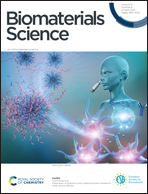Hyaluronic acid–amphotericin B nanocomplexes: a promising anti-leishmanial drug delivery system†
Abstract
The development of an effective amphotericin B (AmB) formulation to replace actual treatments available for leishmaniasis, which present serious drawbacks, is a challenge. Here we report the development of hyaluronic acid–amphotericin B self-assembled nanocomplexes (HA–AmB), processed by freeze-drying (FD) or nano spray-drying (SD), using a simple process that favors the non-covalent drug–polysaccharide association in an amorphous state. These water-soluble formulations, which presented a nanometric size (300–600 nm), high colloidal stability (zeta potential around −39 mV) and an AmB loading (15–18%) in aggregated and super aggregated states, demonstrated less in vitro cytotoxic and hemolytic effects compared to the free-drug. A significant decrease in the number of intramacrophagic L. infantum amastigotes upon treatment (IC50 of 0.026 and 0.030 μM for HA–AmB FD and HA–AmB SD, respectively) was also observed, and the best selectivity index (SI) was observed for the HA–AmB SD nanocomplex (SI of 651). Intravenous administration of the HA–AmB SD nanocomplex for 3 alternate days showed an effective parasite reduction in the spleen and liver of C57BL/6 mice without signs of toxicity commonly observed upon free-AmB treatment. Although lower than that achieved with AmBisome® in the liver, the observed parasite reduction for the nanocomplex was of a similar order of magnitude. The efficacy, stability, safety and low cost of the HA–AmB SD nanocomplex highlight its potential as an alternative treatment for leishmaniasis.



 Please wait while we load your content...
Please wait while we load your content...